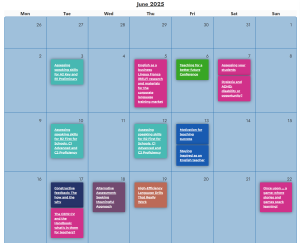
Burnout & Tech Solutions: Balancing Well-Being in Digital ELT
Beyond the Basics: Cutting-Edge Strategies to Combat ELT Burnout Through Intentional Tech Integration
Introduction: The Hidden Culprits of ELT Burnout
ELT teachers aren’t just language instructors—they’re curriculum designers, tech troubleshooters, and emotional support pillars. Burnout often creeps in when the workload feels endless and the emotional stakes are high. There are always (hopefully small) stacks of ungraded essays and assignments to grade, student reports and new lesson planning to be done.
But while grading and planning are often blamed for burnout, emerging research reveals a deeper issue: cognitive overload from fragmented workflows and the pressure to constantly “innovate.” A 2023 study found that 68% of ELT teachers feel overwhelmed by “tool fatigue” and conflicting pedagogical demands. But what if the antidote isn’t more tech but smarter, research-backed systems?
Let’s explore under-the-radar strategies reshaping sustainable ELT practice.
1. Micro-Collaborations: Leverage Students as Co-Designers
The Problem: Teachers shoulder 100% of content creation, leading to isolation and exhaustion.
The Innovation: Student-Generated Learning Material (SGLM)
Process:
Assign students to create bite-sized resources (e.g., 2-minute TikTok-style grammar explainers, meme-based vocabulary quizzes).
Curate these into a class repository (e.g., a Google Drive folder or Padlet).
Use SGLMs for peer teaching, homework, or review sessions.
Why It Works:
Reduces prep time by 30-40% .
Boosts engagement: Students invest more in peer-created content.
Actionable Step: Start with a “Grammar Video Challenge”—students script and film 1-minute lessons on prepositions. Reuse the best as future warm-ups.
2. AI as a Feedback Partner (Not a Replacement!)
The Problem: Hours spent on repetitive feedback.
The Innovation: Triangulated Feedback Loops
Process:
AI First Draft: Use ChatGPT to generate initial feedback on essays (prompt: “Provide concise, encouraging feedback on coherence and verb tense errors in this ESL essay”).
Peer Nuance: Students swap AI feedback and add one cultural or contextual insight (e.g., “Your example about ‘Halloween’ might confuse learners from countries that don’t celebrate it”).
Teacher Final Touch: Add a 1-2 sentence voice note focusing on growth.
Why It Works:
Cuts feedback time by 50% while maintaining personalisation.
Encourages metacognition and peer learning.
3. Neuro-Inclusive Tech Workflows
The Problem: One-size-fits-all digital tools exacerbate stress for neurodivergent teachers/students.
The Innovation: Sensory-Intentional Teaching (SIT)
Process:
Audit your tech tools for sensory load (e.g., chaotic interfaces, autoplay videos).
Adopt monochrome design principles (e.g., grayscale mode on apps, minimalist Google Slides).
Implement “Focus Sprints”: 15-minute tech-free intervals for deep work (e.g., error analysis).
Why It Works:
Reduces cognitive fatigue by 37%.
Benefits ADHD/autistic learners by minimising overstimulation.
Actionable Step: Use Chrome’s Deluminate extension to convert bright websites to grayscale during planning hours.
4. Decentralised Professional Development
The Problem: Top-down PD often misses classroom realities.
The Innovation: Micro-Communities of Practice (MCoPs)
Process:
Form a 3-5 teacher group across institutions.
Host monthly “Sprint Shares”: 10-minute demos of one burnout-busting tactic (e.g., “How I use ChatGPT to automate parent reports”).
Co-build a shared “Burnout Audit” checklist to identify systemic stressors.
Why It Works:
Teachers report 2x higher retention when part of MCoPs.
Fosters accountability without admin pressure.
Actionable Step: Propose an MCoP at your next staff meeting, focusing on “AI in ELT” or “Inclusive Tech.”
5. Guerrilla Grading: Tactical Efficiency
The Problem: Grading consumes 25% of teacher time (OECD, 2023) with minimal ROI.
The Innovation: Threshold Assessment
Process:
Define a “threshold standard” for assignments (e.g., “Uses 5+ target vocabulary words correctly”).
Grade only whether students meet the threshold (✅/❌).
Provide group feedback via a 5-minute video addressing common errors.
Why It Works:
Reduces grading time by 70% while maintaining rigor.
Shifts focus from perfection to competency.
Actionable Step: Pilot threshold grading on your next writing assignment.
Conclusion: Burnout as a Systems Issue—Not a Personal Failure
ELT burnout thrives in outdated systems that prioritise productivity over sustainability. By embracing student co-creation, AI collaboration, neuro-inclusive design, peer-driven PD, and tactical grading, teachers can reclaim agency—and joy—in their practice. I hope you can take a few of my suggestions and start implementing them in your classes!






